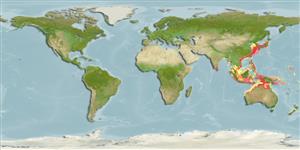Environment: milieu / climate zone / depth range / distribution range
Ecología
marino demersal. Tropical
Indo-West Pacific: Shizuoka Prefecture, Japan to the West Pacific.
Tamaño / Peso / Age
Maturity: Lm ? range ? - ? cm
Max length : 35.0 cm SL macho / no sexado; (Ref. 559)
Espinas dorsales (total): 0; Radios blandos dorsales (total): 13; Espinas anales 0; Radios blandos anales: 12. Body covered with prickles. Caudal fin double emarginate, middle of fin convex. Blackish-brown dorsally, silver ventrally. Pectoral and dorsal fins dark; anal fin white; caudal fin black with upper and lower white tips (Ref. 559).
Life cycle and mating behavior
Madurez | Reproducción | Puesta | Huevos | Fecundidad | Larva
Masuda, H., K. Amaoka, C. Araga, T. Uyeno and T. Yoshino, 1984. The fishes of the Japanese Archipelago. Vol. 1. Tokai University Press, Tokyo, Japan. 437 p. (text). (Ref. 559)
IUCN Red List Status (Ref. 130435)
Threat to humans
Poisonous to eat (Ref. 9137)
Human uses
Más información
ReferenciasAcuiculturaPerfil de acuiculturaRazasGenéticaElectrophoresesheritabilidadEnfermedadesProcesamientoNutrientsMass conversion
ColaboradoresImágenesStamps, Coins Misc.SonidosCiguateraVelocidadTipo de nataciónSuperficie branquialOtolitosCerebrosVisión
Herramientas
Special reports
Download XML
Fuentes de Internet
Estimates based on models
Preferred temperature (Ref.
123201): 17.5 - 28.1, mean 26.5 °C (based on 426 cells).
Phylogenetic diversity index (Ref.
82804): PD
50 = 0.5005 [Uniqueness, from 0.5 = low to 2.0 = high].
Bayesian length-weight: a=0.02089 (0.00927 - 0.04708), b=2.87 (2.69 - 3.05), in cm total length, based on LWR estimates for this Genus-body shape (Ref.
93245).
Nivel trófico (Ref.
69278): 3.7 ±0.4 se; based on size and trophs of closest relatives
Resiliencia (Ref.
120179): Medio, población duplicada en un tiempo mínimo de 1.4-4.4 años (Preliminary K or Fecundity.).
Fishing Vulnerability (Ref.
59153): Low to moderate vulnerability (33 of 100).
